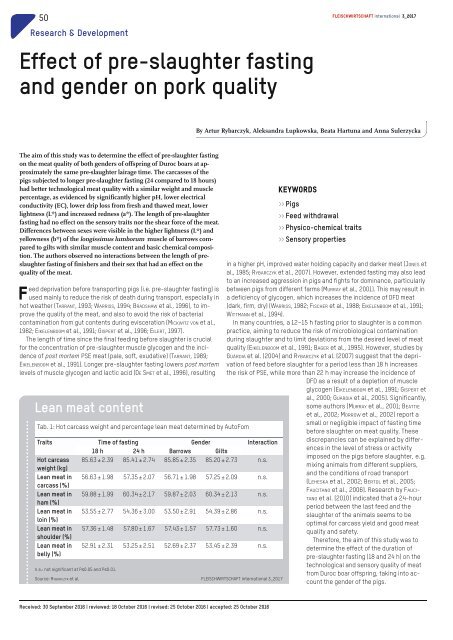FLEISCHWIRTSCHAFT international 3/2017
You also want an ePaper? Increase the reach of your titles
YUMPU automatically turns print PDFs into web optimized ePapers that Google loves.
...............................................<br />
50<br />
Fleischwirtschaft <strong>international</strong> 3_<strong>2017</strong><br />
Research &Development<br />
Effect of pre-slaughter fasting<br />
and gender on pork quality<br />
By Artur Rybarczyk, Aleksandra Łupkowska, Beata Hartuna and Anna Sulerzycka<br />
The aim of this study was to determine the effect of pre-slaughter fasting<br />
on the meat quality of both genders of offspring of Duroc boars at approximately<br />
the same pre-slaughter lairage time. The carcasses of the<br />
pigs subjected to longer pre-slaughter fasting (24 compared to 18 hours)<br />
had better technological meat quality with asimilar weight and muscle<br />
percentage, as evidenced by significantly higher pH, lower electrical<br />
conductivity (EC), lower drip loss from fresh and thawed meat, lower<br />
lightness (L*) and increased redness (a*). The length of pre-slaughter<br />
fasting had no effect on the sensory traits nor the shear force of the meat.<br />
Differences between sexes were visible in the higher lightness (L*) and<br />
yellowness (b*) of the longissimus lumborum muscle of barrows compared<br />
to gilts with similar muscle content and basic chemical composition.<br />
The authors observed no interactions between the length of preslaughter<br />
fasting of finishers and their sex that had an effect on the<br />
quality of the meat.<br />
Feed deprivation before transporting pigs (i.e. pre-slaughter fasting) is<br />
used mainlytoreduce the risk of death during transport, especiallyin<br />
hot weather (TARRANT,1993;WARRISS,1994; BRADSHAW et al., 1996), to improve<br />
the quality of the meat, and also to avoid the risk of bacterial<br />
contamination from gut contents during evisceration (MICKWITZ VON et al.,<br />
1982; EIKELENBOOM et al., 1991;GISPERT et al., 1996; EILERT,1997).<br />
The length of time since the final feeding before slaughter is crucial<br />
for the concentration of pre-slaughter muscle glycogen and the incidence<br />
of post mortem PSE meat (pale, soft, exudative) (TARRANT,1989;<br />
EIKELENBOOM et al., 1991).Longer pre-slaughter fasting lowers post mortem<br />
levels of muscle glycogen and lactic acid (DE SMET et al., 1996), resulting<br />
Lean meat content<br />
Tab. 1: Hot carcass weight and percentage lean meat determined by AutoFom<br />
Traits Time of fasting Gender Interaction<br />
18 h 24h Barrows Gilts<br />
Hot carcass 85.63±2.39 85.41 ±2.74 85.85 ±2.35 85.20±2.73 n.s.<br />
weight (kg)<br />
Lean meat in 56.63±1.98 57.35±2.07 56.71±1.98 57.25±2.09 n.s.<br />
carcass (%)<br />
Lean meat in 59.88±1.99 60.34 ±2.17 59.87±2.03 60.34 ±2.13 n.s.<br />
ham (%)<br />
Lean meat in 53.55±2.77 54.36±3.00 53.50±2.91 54.39 ±2.86 n.s.<br />
loin (%)<br />
Lean meat in 57.36±1.48 57.80±1.67 57.43±1.57 57.73±1.60 n.s.<br />
shoulder (%)<br />
Lean meat in<br />
belly(%)<br />
52.91 ±2.31 53.25±2.51 52.69±2.37 53.45±2.39 n.s.<br />
n.s.: not significant at P≤0.05 and P≤0.01.<br />
Source: RYBARCZYK et al. <strong>FLEISCHWIRTSCHAFT</strong> <strong>international</strong> 3_<strong>2017</strong><br />
Keywords<br />
» Pigs<br />
» Feed withdrawal<br />
» Physico-chemical traits<br />
» Sensory properties<br />
in ahigher pH, improved water holding capacity and darker meat (JONES et<br />
al., 1985; RYBARCZYK et al., 2007). However, extended fasting may also lead<br />
to an increased aggression in pigs and fights for dominance, particularly<br />
between pigs from different farms (MURRAY et al., 2001).This may result in<br />
adeficiency of glycogen, which increases the incidence of DFD meat<br />
(dark, firm, dry) (WARRISS,1982;FISCHER et al., 1988; EIKELENBOOM et al., 1991;<br />
WITTMANN et al., 1994).<br />
In many countries, a12–15 hfasting prior to slaughter is acommon<br />
practice, aiming to reduce the risk of microbiological contamination<br />
during slaughter and to limit deviations from the desired level of meat<br />
quality (EIKELENBOOM et al., 1991;BAGER et al., 1995). However, studies by<br />
GUÀRDIA et al. (2004) and RYBARCZYK et al. (2007) suggest that the deprivation<br />
of feed before slaughter for aperiod less than 18 hincreases<br />
the risk of PSE, while more than 22 hmay increase the incidence of<br />
DFD as aresult of adepletion of muscle<br />
glycogen (EIKELENBOOM et al., 1991; GISPERT et<br />
al., 2000; GUÀRDIA et al., 2005). Significantly,<br />
some authors (MURRAY et al., 2001; BEATTIE<br />
et al., 2002; MORROW et al., 2002) report a<br />
small or negligible impact of fasting time<br />
before slaughter on meat quality.These<br />
discrepancies can be explained by differences<br />
in the level of stress or activity<br />
imposed on the pigs before slaughter, e.g.<br />
mixing animals from different suppliers,<br />
and the conditions of road transport<br />
(LEHESKA et al., 2002; BERTOL et al., 2005;<br />
FAUCITANO et al., 2006). Research by FAUCI-<br />
TANO et al. (2010)indicated that a24-hour<br />
period between the last feed and the<br />
slaughter of the animals seems to be<br />
optimal for carcass yield and good meat<br />
quality and safety.<br />
Therefore, the aim of this study was to<br />
determine the effect of the duration of<br />
pre-slaughter fasting (18 and 24 h) on the<br />
technological and sensory quality of meat<br />
from Duroc boar offspring, taking into account<br />
the gender of the pigs.<br />
Received: 30 September 2016 |reviewed:18October 2016 |revised:25October 2016 |accepted: 25 October 2016

















